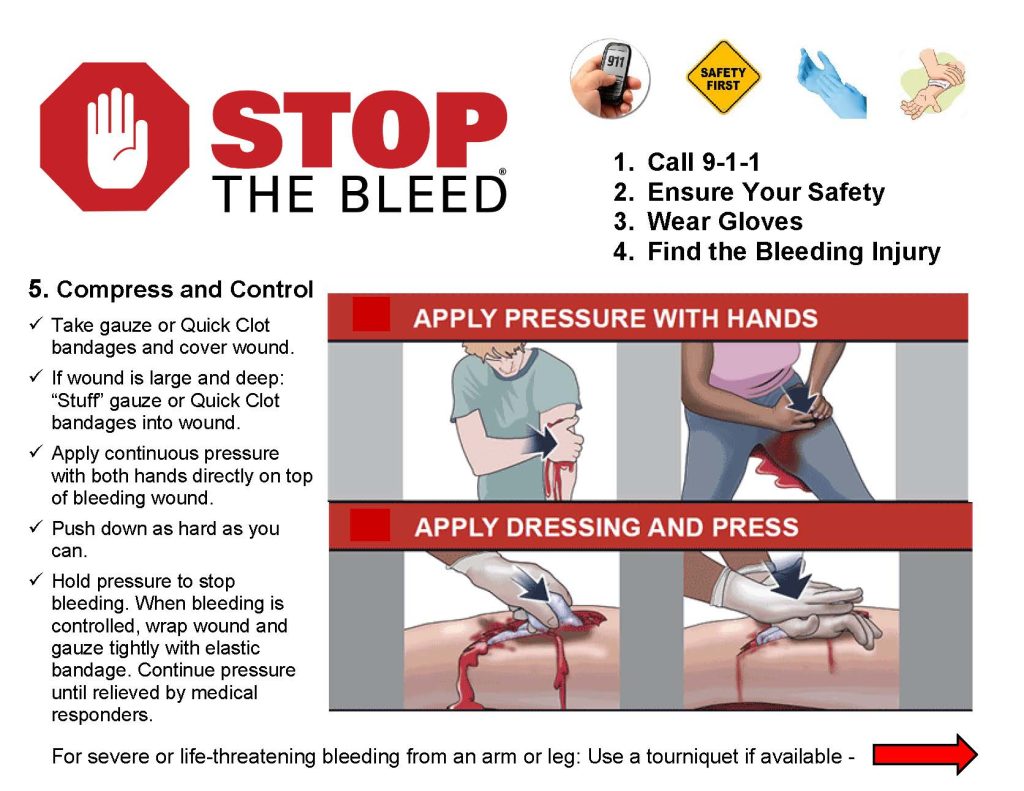Uncontrolled Bleeding: How to Treat the Emergency

Uncontrolled bleeding in the U.S. is preventable. However, it’s the cause of a large number of deaths each year. Statistics reveal that acute blood loss or shock accounts for over 40% of trauma-related fatalities. To increase the odds of survival, knowing how to control bleeding is a valuable emergency first aid skilll.
Let’s go over ways to control the bleeding until emergency assistance arrives.
Life-threatening bleeding from trauma can happen in a variety of circumstances. Active shooter situations, stabbings, natural disasters, car accidents, or work-related injuries are some examples.
When blood flow is severe, you’ll see pooling, which equates to the loss, on average, of about a half can of soda. If you’re a bystander in one of these situations, you can make a notable difference. That’s why learning how to control bleeding until emergency help arrives is an important skill
Controlling Bleeding: Knowing the Basic Skills
The simplest and quickest way you can control excessive bleeding is knowing how to apply a tourniquet.
Making A Tourniquet
You can make and apply a tourniquet with relative ease, which can help with limiting blood loss after a traumatic injury. The device, which is used for wounds on the limbs, compresses the region surrounding the lesion to reduce blood flow. You can follow this process until the wound is treated and closed.
If you don’t have access to a medical tourniquet, you can make one with nearly anything that applies circumferential pressure at the wound site.
Understanding how and why to apply a tourniquet to control bleeding is the fundamental skill to know in life-threatening emergencies.
While a tourniquet can be a useful tool for stopping bleeding, you can also cause further harm if you don’t apply it correctly. That’s because a tourniquet drastically limits circulation.
If this happens, your use of a tourniquet may cause permanent harm to nearby nerves and tissues. In rare circumstances, amputation may follow.
When direct pressure alone does not stop bleeding, you should use a tourniquet.
Again, when treating a traumatic wound, you need to act quickly. Uncontrolled bleeding can lead to death within minutes.
In these instances, you need to apply a tourniquet when using direct pressure simply does not work.
Again, you can only treat limbs, such as the arm or leg with a tourniquet. Therefore, you cannot apply a tourniquet to the torso or neck. You need to apply direct and steady pressure to wounds that do not involve the limbs. Never bind the wound in these situations.
If the wound is close to a joint and does not affect a limb, apply direct pressure just above the joint.
Types of Makeshift Tourniquets
When applying a tourniquet, you may have to improvise. You can use tourniquets in the form of a belt, scarf, bandanna, shirt sleeve, or pant leg. Whatever tourniquet you use, make sure the surface is broad and thick enough to protect the limb. To equally place pressure over a limb, chose a tourniquet from two to four inches wide.
Never use wires or shoelaces.
How to Apply the Tourniquet
Apply uniform pressure as your wrap the tourniquet around the limb. To prevent neurovascular injury, lie the material flat against the skin. Wrap it around several times for added cushioning.
To make a torsion device, when using a fabric, tie a stiff item, such as a pen or stick, onto the outer part of the tourniquet. Twist the stick to tighten it. Then twist one more time to secure it. Tie a knot to hold the stick or pen in place.
If possible, after adding the tourniquet, apply direct pressure. Immobilize the wound site before dialing 911. You should only use this emergency measure until medical help arrives. If you leave the tourniquet on for too long (over two hours), neurological damage may occur.
If you have access to a first aid kit, you can use a hemostatic bandage, sterile gauze or other clean material to apply direct pressure to the bleeding wound and stop further blood flow. Again, applying compression is the best and quickest way to contain an excess loss of blood.
Take a Course in First Aid
Knowing how to stop bleeding or control blood loss is a valuable lifesaver skill. To ensure you understand the process, take a first aid course along with CPR training. An onsite course will give you more information and hands-on skills in these areas.
If you’re an employer, do your employees have the skills needed to handle an emergency? If not, it’s a great idea to sign up for first aid and CPR training in a class setting.
In-Pulse CPR offers classes in Minnesota, Pennsylvania, Florida, and Tennessee



